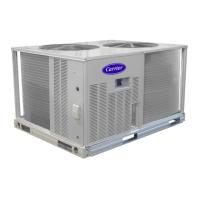16
AIRFLOW
SUCTION
CIRCUIT 2
SUCTION
CIRCUIT 1
AIRFLOW
15 DIAMS
MIN
10
DIAMS
8 DIAMS
MIN
TXV
SENSING
BULB
EQUALIZER LINE
SIGHT
GLASSES
TXV
CKT 2
FILTER
DRIERS
LIQUID LINE
SOLENOID VALVE
CIRCUIT 2
FLOW
LIQUID LINE
SOLENOID VALVE
CIRCUIT 1
FLOW
TXV
SENSING
BULB
TXV
CKT 1
8 DIAMS
MIN
15 DIAMS
MIN
10
DIAMS
Dual Circuit Coil Piping Configuration
For two circuit condensing units
C10072
Fig. 8 -- Location of Sight Glasses and Filter Driers
Typical 38AUD Systems
Install Liquid Line Solenoid Valve —
It is recommended that a solenoid valve be placed in the
main liqui d line (see Figs. 7 & 8) between the condensing
unit a nd the evaporator coil. Locate the solenoid valve at
the outlet end of the liquid line, near the evaporator coil
connec tions, wit h flow directi on arrow pointed at the
evapora tor coil. Refer to Table 9. (A liquid line solenoid
valve is required when the liquid line length exceeds 23 m
[75 ft].) This valve prevents refrigerant migration (which
causes oil dilution) to the compressor during the off cycle,
at low outdoor ambient temperatures.
Solenoid drop control wiring: control the power to the
liquid line solenoid through a Solenoid Valve Relay (SVR)
in all units. Use part number H N61PC005 (field--supplied,
installed). 38AUZ unit requires one SVR; 38AU D unit
requires two relays.
38AUD units also require a separate control power
transformer for the liquid solenoid valve loads. Use
transformer part number HT01BD 602, according to unit
power supply .
Mount the SVR (and transformer TRAN3 when used) in
unit control box. Connect per wiring schemati c label on
unit or per Fig. 24 (38AUZ) or Fig. 25 (38AUD).
Capacity Control Liquid Line Solenoid Valve :
Evaporator capacity staging control via direct thermostat
control of a liquid solenoid valve on the e vaporator’s
second stage circuit is not possible with 38AU model s. If
this installation is a retrofit for a unit that included
automatic pressure--operated unloading, check the existing
thermostat and liquid solenoi d valve wiring for possible
direct thermostat control of a solenoid valve; re--wire per
Figs. 12 or 13 and 24 or 25.
Selecting an Accumulator –
Becaus e all 38AU models use scroll compresso rs, an
accumulator is not req uir ed . If an accumulato r is to be
added, check the accumulator manufacturer’ s literature
carefully for indicatio n of its suitability for use with
R--410A; look for minimum working pressure of 1380 kPa
(200 psig). Select the accumulator firs t on the basis of its
cataloged minimum capacity (to ns ) to ensure oil retu rn fr om
the accumulator, then on tube size or hold ing capacity.
Make Piping Connections —
Piping connections at the 38AU unit are ball valves with
stub tube extensions. Do not open the unit service valves
until all int erconnecting tube brazing has been completed.
The stub tube connections include
1
/
4
-in SAE service
fittings with Schrader valve cores (see Fig. 9). Before
making any brazed connections to the unit service valves,
remove both Schrader valve caps and cores and save for
re-installation. Connect a source for nit rogen to one of
these service fittings during tube brazing to prevent the
formation of copper oxides inside the tubes at brazed
joints.
Factory
High-Flow
ccess Port
Service Valve
with Stem Cap
Field Service
Access Port
(Schrader core)
Sweat
Connection
C10203
Fig. 9 -- Typical Piping Connection Assembly
When conne cting the field tubing to the 38AU se rvice
valves, wrap t he valves in wet rags to prevent ove rheating
Pressure-test all joints from outdoor unit connections over
to the evaporator coil, using nitrogen as pressure and with
soap-and-bubbles.
When pressure-testing is completed, remove the nitrogen
source at the outdoor unit service val ves and re-install the
two Schrader valve cores. Torque the cores to 23-34 N-cm
(2-3 in-lbs).
Evacuation/Dehydration —
Evacuate and dehydrate the connected refrigeration
system(s) (excluding the 38AU unit) to 500 m icrons using
a two-stage vacuum pump attached to the service ports
outside t he 38AU servi ce valves, fol lowing description in
GTAC II, Module 4, System Dehydration.
UNIT OPERATION AND SAFETY HAZARD
Failure to foll ow this warning could cause personal
injury, death and/or equipment damage.
Puron
R
(R--410A) refrigerant systems operate at
higher pressure than standard R--22 systems. Do not
use R--22 service equipme nt or components on Puron
refrigerant equipment.
!
WARNING
38AU

